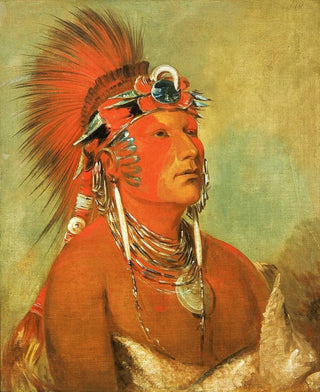Art print | Jeehohshah cannot be thrown to the ground as a warrior - George Catlin


View from behind

Frame (optional)
In the vast panorama of 19th-century American art, George Catlin's work stands out for its ability to capture the essence of Native American cultures during a pivotal time in history. The art print Jeehohshah ne peut pas être jeté à terre en tant que guerrier - George Catlin represents a moment of deep reflection on the identity, bravery, and spirituality of indigenous peoples. Through this piece, Catlin does more than paint a portrait; he immortalizes a soul, a warrior whose intense gaze seems to challenge the viewer, inviting them to delve into a often unfamiliar world. This work, like many others by the artist, is an open window into forgotten stories, living traditions, and wild beauty.
Style and uniqueness of the work
George Catlin's style is characterized by meticulous attention to detail and a vibrant color palette that evokes the richness of landscapes and costumes of Native American tribes. In Jeehohshah ne peut pas être jeté à terre en tant que guerrier, each brushstroke appears imbued with profound meaning, and every visual element is carefully designed to convey a story. Catlin employs dynamic poses and balanced composition to bring his subjects to life. The warrior, draped in traditional ornaments, embodies not only physical strength but also an intrinsic spirituality that transcends time. The way Catlin juxtaposes the character with a suggestive background allows the viewer to feel the tension between the wild nature and human culture, a duality at the heart of his work.
The artist and his influence
George Catlin, often regarded as one of the first artists to document Native American cultures, dedicated his career to preserving these traditions in the face of colonial expansion. His commitment goes beyond mere artistic representation; it is a mission to safeguard a threatened heritage. Catlin traveled across the United States, meeting tribes, participating in their rituals, and immersing himself in their stories to better transcribe them onto canvas. His influence extends beyond

Matte finish

View from behind

Frame (optional)
In the vast panorama of 19th-century American art, George Catlin's work stands out for its ability to capture the essence of Native American cultures during a pivotal time in history. The art print Jeehohshah ne peut pas être jeté à terre en tant que guerrier - George Catlin represents a moment of deep reflection on the identity, bravery, and spirituality of indigenous peoples. Through this piece, Catlin does more than paint a portrait; he immortalizes a soul, a warrior whose intense gaze seems to challenge the viewer, inviting them to delve into a often unfamiliar world. This work, like many others by the artist, is an open window into forgotten stories, living traditions, and wild beauty.
Style and uniqueness of the work
George Catlin's style is characterized by meticulous attention to detail and a vibrant color palette that evokes the richness of landscapes and costumes of Native American tribes. In Jeehohshah ne peut pas être jeté à terre en tant que guerrier, each brushstroke appears imbued with profound meaning, and every visual element is carefully designed to convey a story. Catlin employs dynamic poses and balanced composition to bring his subjects to life. The warrior, draped in traditional ornaments, embodies not only physical strength but also an intrinsic spirituality that transcends time. The way Catlin juxtaposes the character with a suggestive background allows the viewer to feel the tension between the wild nature and human culture, a duality at the heart of his work.
The artist and his influence
George Catlin, often regarded as one of the first artists to document Native American cultures, dedicated his career to preserving these traditions in the face of colonial expansion. His commitment goes beyond mere artistic representation; it is a mission to safeguard a threatened heritage. Catlin traveled across the United States, meeting tribes, participating in their rituals, and immersing himself in their stories to better transcribe them onto canvas. His influence extends beyond






